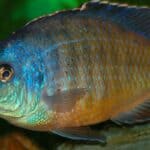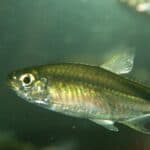There’s a new addition to your tank: the Red Eye Tetra. So what is this little fishy friend, and how can you take care of it?
In this Red Tetra 101 article, we’ll explain everything you need to know about this fish, from its care and diet to tank size and tank mates.
The Red Eye Tetra (Moenkhausia sanctaefilomenae) are found over a wide area of South America. They are named for their bright red eyes and striking silver bodies. They’re relatively easy to care for and make an attractive addition to any aquarium.
Species Summary
This fish gets its name from the distinctive red coloration around its eyes. A native of South America, the Red Eye Tetra, is found in the São Francisco, Paraná, Paraguay, and Uruguay basins. They prefer clear water rivers that are densely vegetated and are a common sight in the Pantanal.
They’re also a little larger than other tetras, which makes them perfect for a medium to a large aquarium. Plus, their unique color scheme is sure to make a significant impact in your aquarium, especially when they’re in a small school.
Red Eye Tetra Care Guide
In this guide section, we’ll teach you how to take care of your Red Eye Tetra. We’ll cover topics such as diet, tank setup, and common health problems.
Tank Size
Red Eye Tetras are highly active fish and should be kept in schools, with ample free space for swimming. A minimum 36″ x 15″ x 12″ or 28-gallon tank is a good size to start with a small school. But, like most shoal fish, the more space available and the greater the number of individuals in the shoal, the better for the welfare of the fish.
Tank Mates
These peaceful fish get along with just about any other fish, making them the perfect tankmates. However, there are a few things to remember when adding Red Eye Tetra to your tank.
First, avoid aggressive, large fish that might injure them. Second, they may nibble on the fins of fish with very flashy fins, like Bettas and Guppies. So, if you have either of those fish in your tank, pay extra attention to ensure everyone is getting along.
The best tank mates for Red Eye Tetra include: Buenos Aires Tetra, Rasboras, Black Skirt Tetra, Molly fish, L.Guntea Loach, Botia Loach, Pencil Fish, Platy Fish, Black Diamond Neon Tetra, Rummy Nose Tetra, Zebra Diano, Giant Danios, Serpae Tetras, Black Neon Tetra, Western Rainbow Fish, and Apple snails.
Same Species Tanks
Red Eye Tetras are often used as a single species in assemblages of Biotope-type aquariums, imitating the original location of the species.
It is a great species to be kept alone in an aquarium of large volume and well decorated. Additionally, it is a large school with many beautiful movements and a beautiful silver constant with bright red dots that bring vitality to any environment.
Water Parameters
As for water conditions, the Red Eye Tetra is not particularly fussy. They can thrive in a wide range of water parameters; the perfect temperature for its maintenance is 72 to 79 F. The ideal pH range is between 6.0 and 8.0, and hardness ranges from 3 to 20°H.
But what do all of these numbers mean?
Temperature is probably essential to keeping your Red Eye Tetras healthy. They prefer warm water, so aim for the upper end of their temperature range. Seventy-two degrees Fahrenheit is about room temperature, so if your home is comfortable for you, it will also be comfortable for your fish.
pH is a measure of how acidic or basic your water is. Red Eye Tetras prefer neutral water, so a pH of 7.0 is ideal. However, they can tolerate a range of pH levels, so if your water is slightly acidic or basic, don’t worry too much.
Hardness is a measure of the number of dissolved minerals in your water. Red Eye Tetras prefer soft water, so a hardness of 3 to 5 degrees is ideal. However, they can tolerate a range of hardness levels, so if your water is slightly harder or softer, they should be fine.
Now that you know the ideal water parameters for Red Eye Tetras, you can provide them with the best possible environment for long and healthy life.
What to Put in Their Tank
In the wild, Red Eye Tetras are found in slow-moving rivers and streams in South America. They inhabit dense vegetation and prefer well-lit areas. In the aquarium, they will do well in a similar environment.
When it comes to keeping your Red Eye Tetra healthy, you need to have a few key things in their tank. A filtering system and an aquarium heater are key to preserving the water at a consistent temperature and clean. Both of these items are important for the health of your fish, so be sure to include them in your setup.
In addition to these two items, you’ll also need to provide your Red Eye Tetra with a few hiding places. This can be in the form of plants or decorations. Having hiding places will help your Tetra feel secure and reduce stress.
Common Diseases
While Red Eye Tetras are very disease-resistant, there are a few common diseases that they are susceptible to. The most common of these is Neon Tetra Disease (NTD).
NTD is a viral disease that is spread through contaminated water. Symptoms of NTD include lethargy, loss of appetite, and white spots on the body. This disease is often fatal in Neon Tetras, but Red Eye Tetras are much more resistant to it. If you suspect your fish has NTD, it is essential to quarantine them immediately and contact your veterinarian.
Food and Diet
Like other tetras, the Red Eye Tetra is omnivorous and will eat a variety of small invertebrates, worms, crustaceans, insects, algae, and plants. Their primary diet in the wild is small invertebrates, but they will readily accept commercial fish food in aquariums.
Providing a varied and balanced diet for Red Eye Tetras is essential. They are usually very hungry fish and will eat anything you give them! Dry, live, and fresh foods such as daphnia, brine shrimp, bloodworms, and mosquito larvae are all excellent choices.
Lifespan
The Red Eye Tetra can be a long-lived and low-maintenance addition to your fish family in a well-maintained aquarium. With proper care, these fish can live for up to 5 years – though the average lifespan is three to four years.
Red Eye tetras are not as long-lived in the wild as their aquarium-dwelling counterparts. These fish are more susceptible to diseases, attacks from other animals, and environmental causes.
Appearance
They feature a classic diamond-shaped body like other tetras. Most of the body is semi-transparent; scales have a particular luminosity. Fins are transparent with a small thin black line around them.
Its accurate color appears on the dorsal and anal fins in a semi-transparent triangular shape, showing beautiful lemon yellow tones with a touch of black. In males, the anal fin is large, pointed, and colorful.
Mature Lemon Tetra has translucent bodies tinged with yellow, with black and yellow spots on their anal and dorsal fins.
Size
Red Eye Tetra fish can quickly grow to 1.8 inches in length when well cared for and fed.
Behavior and Temperament
This little fish is incredibly active and gets along well with other fish of different sizes. However, it’s best to keep it with other active fish because of its high activity level. Calmer fish can be inhibited by the Red Eye Tetra’s energy.
While not necessarily aggressive to other fish species, Red Eye Tetras can occasionally nibble on slow-moving or long-finned fish. This behavior is more evident when kept in insufficient numbers or limited space.
Therefore, keeping a school of at least 6 animals is important. This will allow them to show their natural behavior and bring out their more vibrant colors.
Breeding
The Red Eye Tetra is an oviparous species, which means that the female lays eggs in the environment, close to the substrate. The male will lead the female to release the eggs, which he will then fertilize. Most of the eggs will go to the bottom of the aquarium or will be in the middle of a clump of plants. Eggs hatch within 2 days, and larvae will swim freely within 48 hours.
Breeding aquariums are usually used, with something at the bottom preventing the parents from eating the eggs until they are removed to another location.
Overall, they are easily reproduced fish, where spontaneous reproduction can occur in any domestic aquarium, as long as it is well taken care of.
Gender Differences: Male vs Female
So, what exactly are the differences between male and female Red Eye Tetras? Males are typically smaller than females. They also have a more slender and straight body, whereas females have a thicker and more plump body.
Red Eye Tetra Fun facts
● An ideal fish for any newbie to aquarium hobbyist and found in virtually any retail store around the planet.
● This species is prevalent in the aquarium hobby and commercially reproduced in several countries. In addition, there are artificial varieties of the species, such as balloons and veils.
● Its name, Moenkhausia, comes in honor of Professor William J. Moenkhaus of Indiana University and a collaborator at the Museu Paulista in São Paulo. His epithet sanctaefilomenae (Latin), in honor of Saint Philomena.
● To help trigger the reproduction, after conditioning the pairs, use a separate aquarium. Also, regarding the temperature, leave it a little higher than in the main aquarium and try to leave it with little light.
● Records show the species occurring throughout virtually the entire tropical part of South America below the Amazon region.
Final Thoughts
So, there you have it – some of the key things you should know about Red Eye Tetras. Keep these in mind if you’re considering keeping these beautiful fish as pets, and you’ll surely have a happy and healthy aquarium.
References.
Lima, F.C.T., L.R. Malabarba, P.A. Buckup, J.F. Pezzi da Silva, R.P. Vari, A. Harold, R. Benine, O.T. Oyakawa, C.S. Pavanelli, N.A. Menezes, C.A.S. Lucena, M.C.S.L. Malabarba, Z.M.S. Lucena, R.E. Reis, F. Langeani, C. Moreira et al. …, 2003. Genera Incertae Sedis in Characidae. p. 106-168. In R.E. Reis, S.O. Kullander and C.J. Ferraris, Jr. (eds.) Checklist of the Freshwater Fishes of South and Central America. Porto Alegre: EDIPUCRS, Brasil.
Mills, D. and G. Vevers, 1989. The Tetra encyclopedia of freshwater tropical aquarium fishes. Tetra Press, New Jersey. 208 p.
Zahedi, A., Bolland, S. J., Oskam, C. L., & Ryan, U. (2021). Cryptosporidium abrahamseni n. sp.(Apicomplexa: Cryptosporidiiae) from red-eye tetra (Moenkhausia sanctaefilomenae). Experimental Parasitology, 223, 108089.








